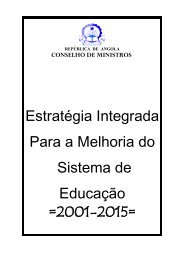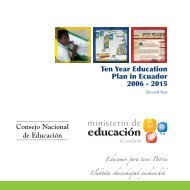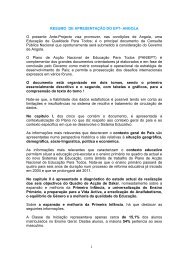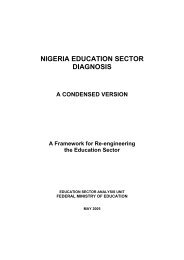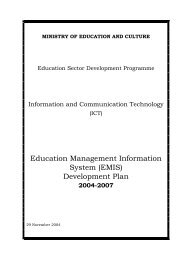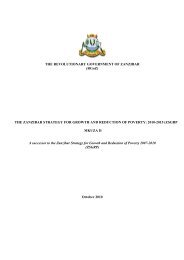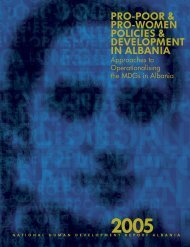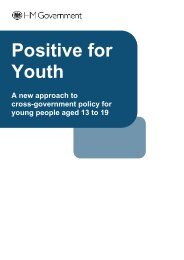Education Sector Strategic Plan 2004-2015 - Planipolis
Education Sector Strategic Plan 2004-2015 - Planipolis
Education Sector Strategic Plan 2004-2015 - Planipolis
Create successful ePaper yourself
Turn your PDF publications into a flip-book with our unique Google optimized e-Paper software.
Final ESSP<br />
mobility of students among disciplines and institutions without loss of earned work.<br />
This integration will also make more attractive other institutions within the Ministry<br />
of <strong>Education</strong> and Sports and those institutions transferred in 1998 from the<br />
ministries of Labour and Social welfare; Health; Tourism, Trade and Industry; Land,<br />
Water and Environment; Agriculture, Information, and Public Service, as they will<br />
allow learners to move among institutions.<br />
(b) Develop facilities to cope with rapidly increasing numbers<br />
The UPE bulge will reach the tertiary sub-system in about 2010, and together with a<br />
steady growth in population and the macro-economic success of Uganda since 1990,<br />
it will result in increased demand for higher education. The Ministry will rehabilitate<br />
existing and construct new facilities, including an Open University and a university<br />
in the East, to meet this demand. It will also encourage the private sector to offer<br />
programs in higher education.<br />
(c) Establish a liberalized financing mechanism and diversify the resource base<br />
The Ministry uses public funds to subsidize Makerere and other universities.<br />
Because of the academic independence of these institutions and the mingling of<br />
public and private funds, it is extremely difficult to account for how public funds are<br />
spent. To address this problem, the Ministry will direct a higher portion of funds to<br />
students rather than institutions, allowing it to specify the disciplines in which these<br />
funds are focused (science and technology). This change will also make the market<br />
for higher education more demand-driven by allowing students to enter the public or<br />
private institution that offers courses that meet their needs, thus leading to better<br />
quality and more attractive programs. In addition, the Ministry plans to de-link<br />
accommodation and tuition fees and allocate more funding toward tuition, thus<br />
partially financing the cost of education for more students. It will also test the<br />
feasibility of a student loan scheme, which would allow even more students to<br />
finance their own education.<br />
3.1.2 Objective 2: Students achieving education goals<br />
Sub-objective 2.1: Primary-level pupils mastering basic literacy (reading and<br />
writing), numeracy, and basic life skills<br />
Strategies<br />
(a) Improve the instructional processes that lead to students' achievement of<br />
literacy, numeracy, and basic life skills<br />
This high-priority strategy comprises five major interventions/undertakings:<br />
(i) The focus will be on helping pupils learn to read and write (literacy) and to<br />
master basic arithmetic and practical mathematics (numeracy). This will take a<br />
16



